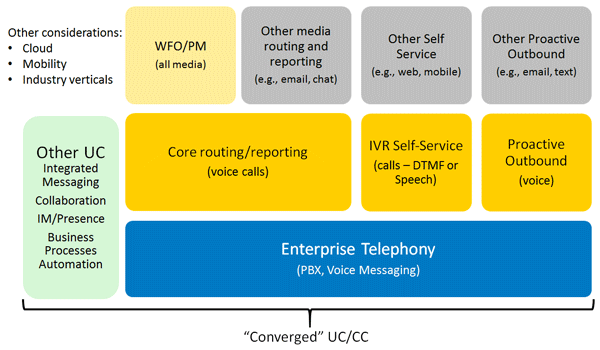Over the years, we’ve watched key players in contact center technology evolve their solution positioning from enterprise communication with contact center (CC) applications, to unified communications (UC), to converging CC and UC. They want the market to take notice as their core technology advances, their product portfolios offer more complete and innovative solutions, and/or they’ve found a new way to fulfill the next big customer need. So where does the contact center fit as the products, labels, and marketing messages change?
Even with varying vendor labels, today’s solutions continue to include three primary components that have been around for years:
- Enterprise communication (dark blue)
- Collaboration (light green)
- Contact center (gold, gray and tan)

In addition, vendors consistently emphasize three elements of their solution portfolios – Cloud, Mobility, and Industry Verticals. Cloud-based solutions offer a host of customer benefits that we’ve captured in previous articles. “Mobile” within an enterprise context responds to the “bring your own device” trend as well offering a consolidated interface on any device – mobile or fixed, PC, tablet or “phone.” Mobile within the contact center context places emphasis on customer media choice based on use of a mobile phone or tablet. Vertical solutions tailor a vendor’s offerings to specific industry requirements and add a communications “story” or use cases with business value to embellish the list of tools.
Every corporation varies in its overall communications plan that has been defined (typically by IT). So every contact center has to figure out where their technology requirements “fit” with IT’s current environment and plans for the enterprise, and where and how it needs to diverge based on its distinct needs.
The contact center can usually treat the enterprise voice path as a commodity provided that it is stable and reliable. Most centers address the limited collaboration tools they need easily and concern themselves with the contact center components they require – whether premise or cloud. As the following table shows, they have a variety of options:
| Categories | Description | Example Vendors |
| CC only | Typically cloud solutions with contact center functionality only Prefer buyers provide the PBX/voice path but require little – e.g., DID lines, internet connectivity | ConnectFirst, Five9, inContact, NewVoiceMedia |
| CC with options for PBX | CC Application focus but can bring partner to the table to provide PBX if buyer requires Increasingly partner with Microsoft (Skype for Business) May partner with or integrate with major PBX players (e.g., Avaya, Cisco, Unify) | Genesys, Aspect |
| CC and PBX | Include PBX and CC as part of their standard offerings | Avaya, Cisco, Interactive Intelligence, Mitel, ShoreTel, 8×8 |
As you think about where your center fits in the overall ecosystem, consider the need for consistency from a technology perspective and, perhaps more importantly, from a process perspective.
- Do you need more from your “PBX” than an available and stable voice path? For example, will you transfer calls throughout the enterprise?
- Are your collaboration requirements more than just an IM/presence tool for the center because you need access to subject matter experts throughout the organization? If so, you’ll need to see if they are available through presence or workstate information.
- If you need tools for customer collaboration (e.g., web co-browsing, video), do your requirements have implications for the overall enterprise solution?
The answers to questions like these will refine how your contact center technology fits with the overall enterprise communications system.
In a perfect world, the contact center’s technology procurement is part of an overarching IT strategy, and any purchase makes progress along a defined roadmap. Short of a full roadmap, purchases should not be viewed in isolation. Think of how your current purchase fits with where you are and where you will be going (to the degree it’s defined). IT may not always focus on the contact center when making their plans or you may be “doing your own thing,” but some level of integration will probably be required.
Understanding your requirements and how they fit in the overall communications ecosystem ensures you retain control of your purchase and that current vendor labels and positioning won’t cause you to go astray.
